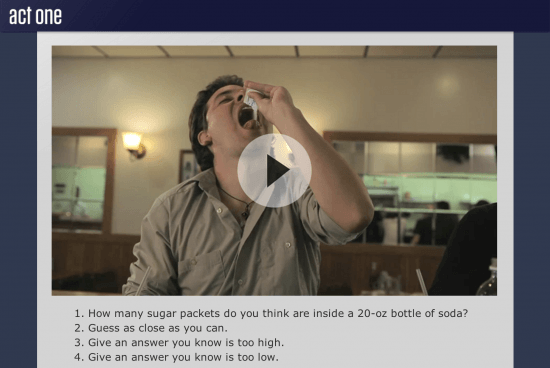Why wait to try one? Engage Your Students Today!
This past May, I travelled to the OAME 2012 Annual Conference in Kingston to present the Tap Into Teen Minds iPad Classroom to colleagues across Ontario. Leading up to the conference, I had heard a lot of buzz about some of the keynote speakers and was constantly being asked by attendees if I would be attending the Dan Meyer session on problem solving. Although I never made it known to anyone, I really didn’t understand how people could be so excited to checkout a math speaker who was going to go on for over an hour about problem solving.
Thinking about a problem solving keynote, the following thoughts crossed my mind:
- who would want to present a topic as dry as problem solving?
- how would I stay awake?
- is there something better I could be doing with my time?
- and the list goes on…
Do these thoughts sound familiar? They are the exact same thoughts students have when their math teacher announces: “Today kids, we’re going to do Problem Solving.”
Three-Act Math Problem Solving the Dan Meyer Way
After hearing such rave reviews after Dan Meyer’s first keynote, I managed to sneak into his second session to see what all the fuss was about. Even at this point, I was still very skeptical. However, I knew that since I was near the back, I’d be able to make an early exit if my eye-lids were malfunctioning. Immediately after the session began, Dan had the audience captivated and eager to learn more; essentially the reaction he looks to gain from his students when teaching mathematics.
The secret comes down to making problem solving in math just like a story. He suggests using multimedia rich resources which allow the students to live the problem. Just like a play, he suggests using three-acts for each problem:
- Act 1 – Use video or other multimedia to set the stage for the problem.
- Act 2 – Allow students to determine what is required to solve the problem. Allowing students to guess a solution or values which are too big and too small. Students learn through conversation and attempt to solve the problem.
- Act 3 – The answer is revealed through multimedia. Much more impactful than using solutions from “the back of the book.”
- Sequel – Most problems can be extended to extend a concept or even incorporate a new concept into the problem.
This is a very stripped down and basic explanation, so I’d suggest taking 10 minutes of your time to watch Dan Meyer’s TED Talk video which dives deep into what he looks to do in his mathematics classroom:
My Attempt at the Sugar Packets Problem
Just today, I used the Sugar Packets problem as a nice minds on problem which I could create a sequel that applies to proportional reasoning as we are focusing on ratios and rates. I have always found proportional reasoning to be a concept that students struggle with and I think it has a lot to do with the lack of real world connections made during a traditional lesson. Sure, we make the problem about mixing a fresh batch of orange juice in the morning, but is juice a topic that’s really going to get someone excited to learn?
Rather than saying “Picture this kids!” you can just press play and say “watch this…”
The Sugar Packets problem is a simple problem which could be used in elementary classrooms up to some early high school classes. The problem is taken from a Healthy Living commercial raising awareness of the high sugar content of pop and promoting healthier beverage choices.
Act 1 – The Hook & The Question
Act One begins with a video showing a guy repeatedly opening packets of sugar and eating them, followed by the statement:
“If you wouldn’t eat _____ packets of sugar… Why would you drink _____ packets of sugar?”
Act 2 – Conversation, Estimations, Solutions
Act Two is where students can have conversations about the problem. What information do you need? How many packs do you really think are in a bottle of pop? The questions are endless.
Act 3 – Confirmation
Once students have shared their answers and what they did to get there, you can start Act Three by showing the full commercial for students to confirm their answers that there are 16 packets (16.25 to be exact) of sugar in a 20 oz. bottle of Coca-Cola.
Sequel – Extend Problem to Your Liking
Since we are entering a unit on proportional reasoning, my Sequel had the students set up a proportion to determine how many ounces of Coca-Cola they must drink to get exactly 1 packet worth of sugar.
I can’t wait to apply another Three-Act Math Story in my classroom and whether they realize it or not, I think my students might be excited as well…


